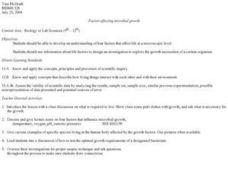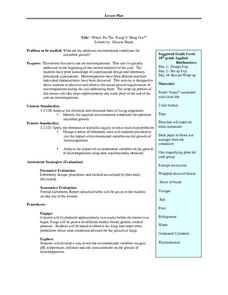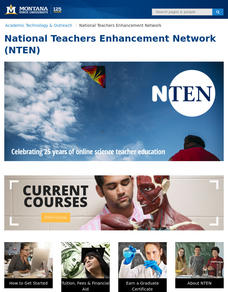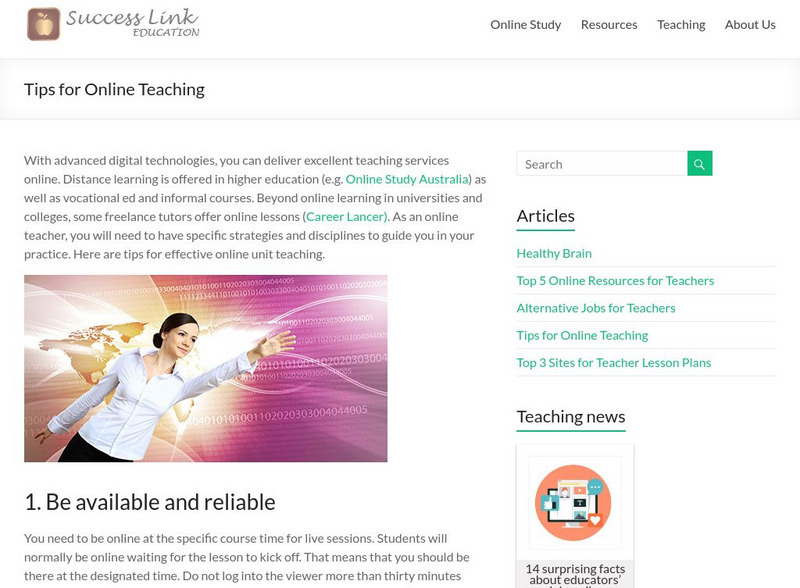Curated OER
Factors Affecting Microbial Growth
High schoolers listen to a lecture on four factors that influence microbial growth and they discuss how to test the optimal growth requirements of a designated bacterium. They design and carry out laboratory investigations to test...
Curated OER
COMPARE SOILS BY GROWING PLANTS
The student will identify the difference in the rate of plant growth in three soils that vary in organic matter.1. Obtain three to four flowerpots, different types of soil, a record chart, three to five beans for each pot, and water....
Curated OER
Microorganisms: Good Guys or Bad Guys?
Students discover the role microorganisms play in our lives. In this decomposition lesson, students examine decaying foods and plants in order to analyze the different bacteria that grows. Students discuss the good and bad of...
Curated OER
Sour Milk Experiment
Students experiment with milk to understand the importance of pasteurization. In this pasteurization lesson, students learn background knowledge about bacteria in milk and the process of pasteurization. They complete an experiment to see...
Curated OER
"Where Do The 'Fungi's' Hang Out?"
Tenth graders engage in a lesson looking for the ideal conditions for microbial growth. The lesson is to be given once they have background knowledge about microbes. Students set up a lab in order to grow cultures over a period of two...
Curated OER
Living in Extreme Environments
Students explore the living conditions needed to grow bacteria. They develop an experiment that will test the ability of bacteria to survive various temperature extremes. In addition, they complete a lab reprt to share their results.
National Wildlife Federation
What's Your Habitat?
How are third graders like rabbits? They both live in habitats and require food, water, and shelter to survive! An educational science lesson encourages your learners to think about their own habitats and survival needs, before comparing...
American Museum of Natural History
Make a Terrarium
Scholars read a brief overview of what a terrarium is and how it creates the greenhouse effect, then click on a link to discover the materials and 10 steps they need to build their own.
Curated OER
A Safe Food Supply? Is Your Food Safe to Eat?
Viewers of this slide show learn that pesticides used on food crops can be harmful, but that there are certain allowable levels that should not be hazardous. They find out the rigorous process of inspection that meat must go through...
Curated OER
Bacteria Aren't All Bad!
Teaching students about the diversity of the Bacteria Kingdoms and their importance to humans
Curated OER
DEMONSTRATING AN EPIDEMIC
Students experience a small scale "epidemic," demonstrating the ease with which disease organisms are spread, and enables the student to determine the originator of the "epidemic." They transfer live bacteria by hand contact, then...
Curated OER
Human Population's Response to Re-emerging and Emerging Infectious Diseases
Young scholars examine the human population response to microbial diseases. In this disease lesson students observe population trends, write about a scientist and evaluate and defend current treatments for infectious diseases.
Curated OER
Dirty Decomposers
Students explore the ecosystem by conducting a ziploc bag experiment. In this recycling lesson, students identify decomposer organisms in our environment and how they speed up the recycling process. Students utilize a ziploc plastic bag,...
Curated OER
Dirt: Making Dirty Water Clean!
Fourth graders study soil and water. In this water instructional activity students work in groups and use a filter to clean water.
Curated OER
Cheese Please
Students make cheese in their classroom! In this cheese lesson plan, students use bacteria and active culture to clot and age cheese that could be edible in the future.
Curated OER
Demonstrating an Epidemic
Learners use an experiment that allows them to experience a small scale "epidemic", demonstrating the ease with which disease organisms are spread. Students determine the originator of the epidemic. They transfer live bacteria by hand...
Curated OER
Ecosystems and Climate
Students examine climatic effects on ecosystems. They plant tomatoes and observe the differences in plant growth with differences in light. They create picture collages of plants, animals, and insects found in each climate of the U.S.
Curated OER
Life in Streams and Ponds
Students collect microorganisms, demonstrate correct laboratory/Gram stain procedure, and design and construct tables to organize data.
BioEd Online
Bio Ed Online: The Science of Microbes: Microbes Are Everywhere
Middle schoolers learn how to safely work with microbes in petri dishes, and how quickly they can develop into colonies. The lesson and a set of PowerPoint slides can be downloaded. An accompanying instructional video is 10 min. 24 sec.
University of Missouri
Microbes in Action: Classroom Activities: Composting by Microbes
A science experiment to observe how materials decompose over time, By recording the smell, appearance, and movement of materials over three weeks, students will be able to make conclusions about their decompositions. Students will also...
Success Link
Success Link: Microorganisms
Lesson plans to examine bactieria and how they grow. The main lesson page indicates that there are seven training labs, but there are only two operating links. Those two are worth exploring.
Other
Tea: Some Like It Hot, Some Like It Cold Microbial Life
A science lab to determine the optimal temperature for common bacteria to grow. Students will graph their data to analyze and focus on bacteria that live in extreme conditions. To complete this experiment students will perform a gram stain.
ClassFlow
Class Flow: Microorganisms
[Free Registration/Login Required] In this unit children learn that there are many very small organisms called microorganisms which feed, grow and reproduce and which may be harmful or beneficial.
City University of New York
Brooklyn College: Direct Microscopic Counts
Guidelines for an activity through which you, acting as a research assistant for a wine merchant, work to grow a microbe under different conditions.























